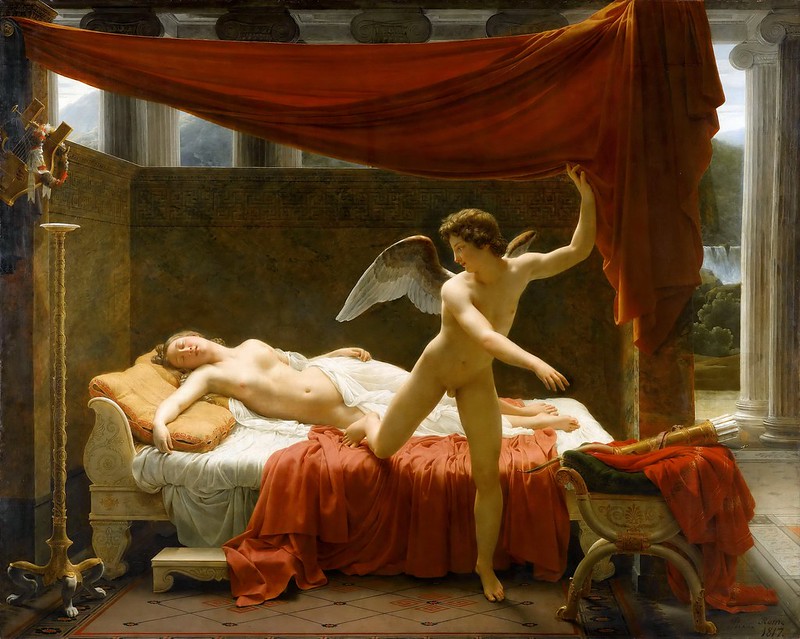Obra de François-Édouard Picot (1786-1868), pintor francès (1)
- Recordatori d'Antoine de Lhoyer -
En el dia de la commemoració del seu 164è aniversari de decés
Parlem de Pintura...
François-Édouard Picot (Paris, 17 d'octubre de 1786 - Paris, 15 de març de 1868) va ser un pintor francès. Es va formar amb els pintors François-André Vincent i Jacques-Louis David, assolint poc després un segon lloc al Premi de Roma (1811). De tornada a París després d'un viatge d'estudis a Roma, va exposar "Cupido i Psique" al Saló de París de 1819, i el mateix any va pintar, "La mort de Safira" per a l'església de Saint-Séverin de París. Va ser elegit membre de l'Acadèmia de Belles Arts el 1836 i va continuar exhibint les seves pintures al Saló fins el 1839. Conjuntament amb Hippolyte Flandrin, va decorar l'església de Saint-Vincent-de-Paul de París i també va fer pintures i frescs per al Museu del Louvre, el Palau de Versalles i el Palau de Luxemburg. Entre alters, va ser pintor de temàtica històrica, de retrats i d'escenes de gènere. No obstant i al llarg de la seva vida va ser més apreciat pels mèrits de la seva docència que pròpiament pel seu talent com a pintor. Va morir a París el març de 1868.
Font: En català: François-Édouard Picot (1786-1868) - En castellano: François-Édouard Picot (1786-1868) - In english: François-Édouard Picot (1786-1868) - Altres: François-Édouard Picot (1786-1868)
Parlem de Música...
Antoine de Lhoyer (Clermont-Ferrand, 6 de setembre de 1768 - Paris, 15 de març de 1852) va ser un guitarrista i compositor francès. Amb 20 anys va començar la seva carrera militar reialista però la Revolució Francesa el va obligar a emigrar el 1791. El 1800 es va establir com a professor de guitarra a Hamburg, però el 1802 va viatjar a Sant Petersburg, on hi va romandre durant 10 anys com a guitarrista de la Cort del Tsar Alexandre I de Rússia. Va tornar a França el 1812 i es va reunir amb l'exèrcit després de la restauració de Lluís XVIII el 1814. Com a oficial de l'exèrcit va ocupar diversos càrrecs en les províncies franceses en els anys següents situant-se, fins i tot, a la llunyana Algèria a partir del 1836. Va morir en la pobresa a París el març de 1852.
Font: En català: No disponible - En castellano: No disponible - In english: Antoine de Lhoyer (1768-1852) - Altres: Antoine de Lhoyer (1768-1852)
Font: En català: No disponible - En castellano: No disponible - In english: Antoine de Lhoyer (1768-1852) - Altres: Antoine de Lhoyer (1768-1852)
Parlem en veu pròpia o en veu d'altri...
The exquisite composition that Jean-Michel Damase (Bordeaux, 1928) dedicated in 2004 to the guitar trio, takes us to modern-day France, in spite of being devoted to evoking a nostalgic retro mood. Quatre pour trois, in fact, does nothing to hide the deep admiration that Damase professes for the Parisian music of the Belle Epoque period and, of course, for its distinguished founders, Debussy, Faure and Ravel. Functioning as a kind of stylistic watershed, the following piece, takes us towards the Central European cultural scene, which developed right at the very beginning of the Twentieth Century. In spite of its small size, the Rondo fur Drei Gitaren by the German composer Paul Hindemith (Hanau, 1895-Frankfurt en Main, 1963) can without doubt be considered one of the masterpieces of the chamber music repertoire for the classical guitar. We end the musical journey undertaken in this CD by returning once more to Italy, where we began. Two pieces are now presented written expressly for the Trio Nahual by the young guitarist, composer and painter Marco De Biasi (Vittorio Veneto, 1977). The first piece, Eires (The title is derived from the word "serie" read backwards) is a theme with variations in six sections. The theme, conceived in the vein of a freely treated serialism, is characterized by a captivating melodic line spread between the three guitars. The various thematic units are later taken up and developed in different ways so as to create the five variations that, alternating opposing characters and sound settings between them, range from the South American sounding waltz, to the languid central recitative, to the wild counterpoint of the final variation.
AMAZON (source/font: aquí)
Gaudiu i compartiu!
Informació addicional...


Un administrador del blog ha eliminat aquest comentari.
ResponElimina